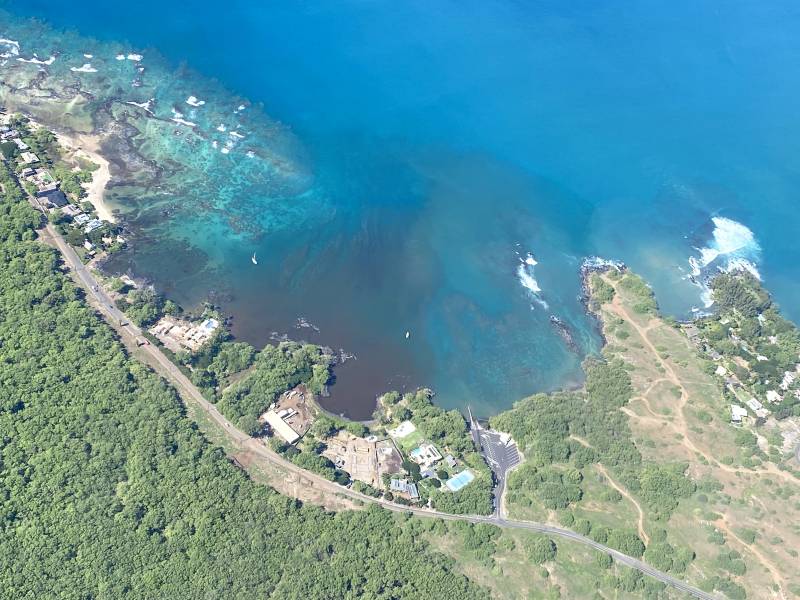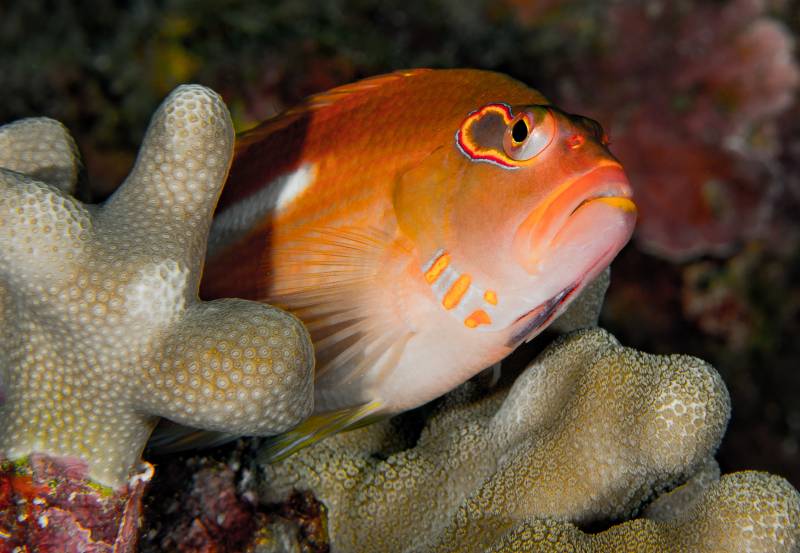The Kumulipo, a Hawaiian creation chant of 2,102 lines, begins with darkness. It says out of the darkness was born a male and a female source. And next, line fifteen out of over two thousand, says:
Hanau ka ‘Uku-ko‘ako‘a, hanau kana, he ‘Ako‘ako‘a, puka
Born was the coral polyp, born was the coral, came forth.
Hundreds of lines follow detailing the emergence of the flora and fauna of the sea, and the interrelationship between land and sea. This understanding was fundamental to what we would call “conservation” practices, or stewardship, by Hawaiians prior to the arrival of westerners.

Aerial photo showing sedimentation effects of runoff affecting coral reefs. Photo credit: Greg Asner, Director, ASU Center for Global Discover and Conservation Science
In reviewing the five years of our Conservation and Legacy Lands practice, I forgot to mention this key learning. Whereas in real estate we think of land as private property, and we therefore think of ʻāina as “land,” the indigenous approach to stewardship of the ahupuaʻa or “land” division includes the associated shoreline and ocean resources. For example, when our Hawaiʻi Life crew volunteered at Alakoko Fishpond last December we learned that the genius of this type of fishpond was as an incubator for fish that were not eaten directly by humans, but made their way to the ocean feeding the food chain up to the larger pelagic fish capable of supporting on-shore human communities.
As the Kumulipo suggests, coral reefs are foundational to the oceanʻs diverse inhabitants and therefore to the resilience of the landʻs inhabitants. When corals are healthy, it is a good indication that the surrounding land and sea ecosystems are healthy. The opposite is also true. With this insight, when we think about the devastation of last monthʻs Maui wildfires, we realize it is not only the land that has been made toxic by the residues from the burning of structures; the nearby ocean ecosystem is suffering from a combination of sedimentation, runoff of toxic chemicals, and debris.
August 9, 2023 also brought the publication of a 20-year interagency study of Hawaiʻi coral reefs and announcement of the ʻĀkoʻakoʻa Restoration Program — a timely bright note as this vital research can help guide thinking about how to address the environmental and social challenges facing West Maui.
Twenty-year Study of Hawaiʻi Coral Reefs Documents Decline – and Contributors to Health
Greg Asner, PhD — the legendary scientist affiliated with Hawaiʻi Marine Education and Research Center and Arizona State Universityʻs Center for Global Discovery and Conservation Science — describes the key takeaways of the 20-year study of coral reefs on West Hawaii Island as follows:
- Reefs with higher levels of pollution (wastewater and sediment) or low herbivore fish stocks were already in decline up through 2014.
- Reefs with the lowest pollution and with the highest herbivore fish stocks were increasing in quality up through 2014.
- Then with our first marine heatwave in 2015, we found that reefs with best water quality and/or high herbivore fish stocks best survived the heatwave.
- If we increase herbivore fish stocks and decrease pollution, we can greatly increase the chance that our reefs will survive repeated marine heatwaves.
The BOLDFACE above is my addition. Development and construction as well as wildfires denude coastal areas, creating more wastewater and sediment pollution. We can help the coral reefs, which are foundational for marine and land ecosystem health, by reducing pollution due to wastewater and sediment. The scientists and their community partners are also working on projects to directly help restore the coral reefs to health.
New Ākoʻakoʻa Restoration Program to Address Coral Health along West Hawaiʻi Coastline

Healthy coral reefs are home to millions of species. Photo credit: Greg Asner, Ph.D.
It is rare to see academic research immediately turned into a proactive initiative, but that is the case with the Arizona State University sponsored coral reef study. The just announced ʻĀkoʻakoʻa Restoration Program is a $25 million collaboration between scientists and community partners bringing local leadership and cultural knowledge. Seeded with a $15 million donation from the Dorrance Family Foundation, additional funding was provided from U.S. Sen. Brian Schatz’s office, the Hawaii Division of Aquatic Resources, the National Oceanic and Atmospheric Administration and ASU.
For those of us who live and work in West Hawaiʻi, close to the 120 miles of coastal reef along its coast that will be the focus of the project, this new initiative is good news indeed. But Professor Asner says lessons learned in ʻĀkoʻakoʻa will be shared with communities across the state of Hawaii and worldwide.
Whether you are a resident or visitor to Hawaiʻi, whether you enjoy the recreational joy of snorkeling and diving along these reefs, the health of the land you live on is vitally interconnected with their wellbeing. What can you do to help?
Stay tuned for future blog posts on topics like the cesspool-to-septic conversion requirements, fire prevention, and development/agricultural runoff prevention strategies, as my thinking on Hawaiʻi conservation and real estate evolves. And donʻt forget you can support also projects focused on the restoration of coastal wetlands and loko iʻa or fishponds.


Leave your opinion here. Please be nice. Your Email address will be kept private, this form is secure and we never spam you.